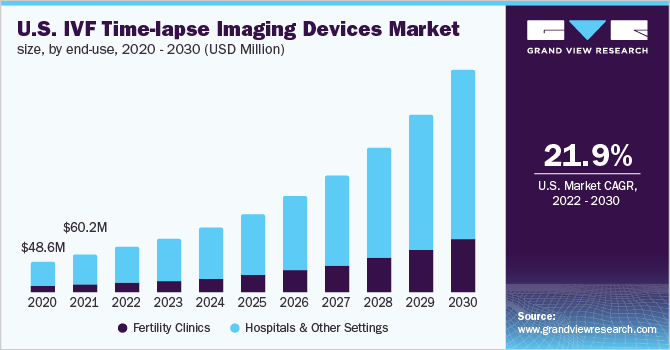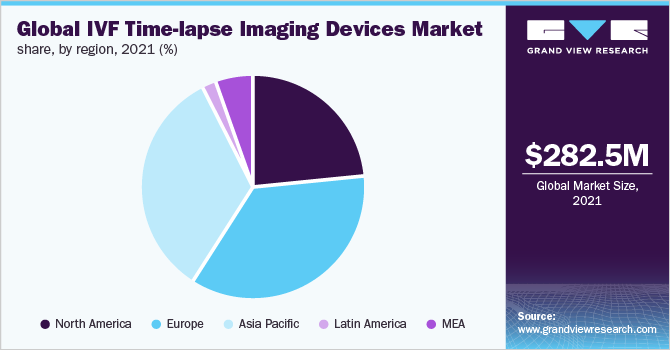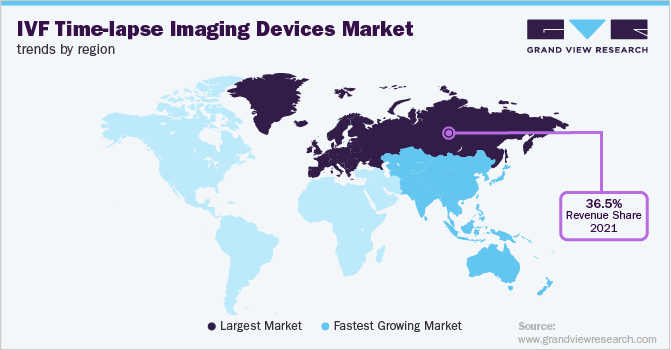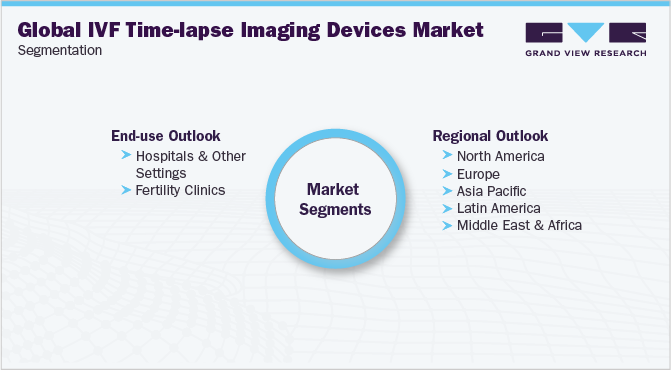- Home
- »
- Medical Devices
- »
-
IVF Time-lapse Imaging Devices Market Size Report, 2030GVR Report cover
![IVF Time-lapse Imaging Devices Market Size, Share & Trends Report]()
IVF Time-lapse Imaging Devices Market Size, Share & Trends Analysis Report By End-use (Hospitals & Other Settings, Fertility Clinics), By Region (North America, Europe, Asia Pacific, Latin America, MEA), And Segment Forecasts, 2022 - 2030
- Report ID: GVR-4-68039-959-2
- Number of Report Pages: 90
- Format: PDF, Horizon Databook
- Historical Range: 2017 - 2020
- Forecast Period: 2022 - 2030
- Industry: Healthcare
Report Overview
The global IVF time-lapse imaging devices market size was valued at USD 282.5 million in 2021 and is expected to expand at a compound annual growth rate (CAGR) of 23.1% from 2022 to 2030 owing to the rise in infertility cases due to sedentary lifestyles. As per the Reproductive Biological, endocrinology infertility affects around 48 million couples across the globe. PCOS is among the most frequent cause of female infertility which is leading to an increase in the demand for assisted reproductive technologies. In addition, the rising disposable income levels are assisting infertile people to opt for IVF treatments.

The IVF time-lapse imaging services witnessed various obstructions due COVID-19 pandemic outbreak. Due to COVID-19, the number of people opting for IVF treatments fell by 90% globally. However, multiple organizations are now undertaking strategies to assist infertile couples. For instance, the Society for Assisted Reproductive Technology (SART) launched its fertility experts podcast series in June 2020. The podcast covers a wide range of fertility-related topics. These initiatives are expected to raise massive public awareness, fueling the demand for infertility treatments. Nova IVF Fertility Clinic in India witnessed more than 30,000 new couples besides the existing ones who have enrolled for fertility assessment and IVF therapy and treatments in 2021.
In February 2021, TMRW Life Sciences also announced the release of the world's first automated Cryo specimen management platform for eggs and embryos used in IVF. The TMRW platform has been launched in several fertility clinics across the U.S., allowing the management of the million embryos and eggs that are central to modern IVF. The time-lapse imaging technology has considerably enhanced successful pregnancy and life birth rates. In June 2021, at the 37th European Society of Human Reproduction and Embryology (ESHRE) Annual Meeting, Life Whisperer invited clinics to take part in the 3rd global IVF clinic collaboration.
The AI Open Project aimed to implement artificial intelligence in the evaluation of oocytes and female eggs previous to fertilization or freezing. The changes or emerging new reforms in the regulatory framework of several nations are expected to expand the accessibility of IVF treatments. For instance, France’s lower house of parliament passed a law that grants single women full rights to opt for medically assisted reproduction. This new law is expected to expand access to fertility treatments like artificial insemination and IVF, which are currently only accessible to infertile heterosexual individuals.
End-use Insights
In 2021, the fertility clinics segment dominated the market for IVF time-lapse imaging devices and held the largest revenue share of 77.6% owing to the growing preference for clinics to undergo IVF treatments. As per the Department of Health and Human Services, approximately 12 to 13 couples out of every 100 face difficulty in conceiving. Since the continuous rise of infertility, more people are turning to IVF services, which is fueling segment growth.
The hospitals and other settings segment is anticipated to witness the fastest CAGR of 24.4% in the market for IVF time-lapse imaging devices over the forecast period. The rising incidence of infertility, the rapid implementation of assisted reproductive technologies in hospitals, the constantly progressing healthcare infrastructure, and the growing availability of well-resourced infrastructure are the key factors driving the segment growth.
Regional Insights
In 2021, Europe dominated the market for IVF time-lapse imaging devices and accounted for a revenue share of 36.5% owing to rising infertility cases and growing fertility tourism in the region. An increasing number of people are traveling to European countries such as Spain, the Czech Republic, and others to receive IVF treatments at a cheaper cost. Moreover, regulations such as the U.K. Human Fertilisation and Embryology Authority (HFEA), which strictly regulates IVF treatments in the U.K. are supporting the market trends. In Germany, due to the falling birth rate of around 2.21 children per woman, IVF treatment subsidies are an important factor in the market growth. In addition, the National Health Plan covers roughly half of the total cost of treatment. It supports three IVF cycles, which is expected to drive the market for IVF time-lapse imaging devices.

In the Asia Pacific, the market for IVF time-lapse imaging devices is projected to witness a promising growth rate over the forecast period. This growth can be attributed to increased awareness of IVF treatments, lower prices, and growth in the rate of infertility. Moreover, as per the Beilstein Journal of Organic Chemistry (BJOC), the Chinese childbearing population discovered that approximately 25% of Chinese women aged 20-49 who wanted to have a child were infertile.

Since the lifting of China's Family Planning policy couples now has the liberty to expand their families or have more children. As per China's National Health and Family Planning Commission, after the policy was relaxed, approximately 90 million Chinese women have become eligible to have a second child, moreover Chinese hospitals noted more second children born than first children in 2017.
Key Companies & Market Share Insights
Geographical expansions through mergers and partnerships are the key strategies being adopted by market players. For instance, in March 2022, Esco Medical completed a major installation of the very first MIRI TL 6-chamber incubator at the Natal Fertility Center in Southern Africa. Natal Fertility Clinic is located throughout Umhlanga, Kwa-Zulu Natal, South Africa. In July 2021, Vitrolife completed the purchase of Igenomix. Vitrolife signed a deal to acquire 100% of the shares of Igenomix S.L. from EQT and other stakeholders, as well as a non-cash consideration issue. Some of the prominent players in the IVF time-lapse imaging devices market include:
-
Vitrolife Sweden AB,
-
Esco Medical Technologies UAB
-
Genea Biomedx PYT LTD.
-
ASTEC CO., LTD.
IVF Time-lapse Imaging Devices Market Report Scope
Report Attribute
Details
Market size value in 2022
USD 339.6 million
Revenue forecast in 2030
USD 1.8 billion
Growth rate
CAGR of 23.1% from 2022 to 2030
Base year for estimation
2021
Historical data
2017 - 2020
Forecast period
2022 - 2030
Quantitative units
Revenue in USD Million and CAGR from 2022 to 2030
Report coverage
Revenue forecast, company share, competitive landscape, growth factors & trends
Segments covered
End-use, region
Regional scope
North America; Europe; Asia Pacific; Latin America; MEA
Country scope
U.S., Canada, U.K., Germany, France, Italy, Spain, Japan, China, India, Brazil, Mexico, South Africa
Key companies profiled
Vitrolife Sweden AB, Esco Medical Technologies UAB, Genea Biomedx PYT LTD., ASTEC CO., LTD.
Customization scope
Free report customization (equivalent to up to 8 analyst working days) with purchase. Addition or alteration to country, regional, and segment scope.
Pricing and purchase options
Avail of customized purchase options to meet your exact research needs. Explore purchase options
Global IVF Time-lapse Imaging Devices Market Segmentation
This report forecasts revenue growth at global, regional, and country levels and provides an analysis of the latest industry trends in each of the sub-segments from 2017 to 2030. For this study, Grand View Research has segmented the global IVF time-lapse imaging devices market report based on end-use and region:

-
End-use Outlook (Revenue, USD Million, 2017 - 2030)
-
Hospitals & Other Settings
-
Fertility Clinics
-
-
Regional Outlook (Revenue, USD Million, 2017 - 2030)
-
North America
-
U.S.
-
Canada
-
-
Europe
-
U.K.
-
Germany
-
France
-
Italy
-
Spain
-
-
Asia Pacific
-
Japan
-
China
-
India
-
-
Latin America
-
Brazil
-
Mexico
-
-
Middle East & Africa
-
South Africa
-
-
Frequently Asked Questions About This Report
b. The global IVF time-lapse imaging devices market size was estimated at USD 282.5 million in 2021 and is expected to reach USD 339.6 million in 2022.
b. The global IVF time-lapse imaging devices market is expected to grow at a compound annual growth rate of 23.08% from 2022 to 2030 to reach USD 1.8 billion by 2030.
b. Europe dominated the IVF time-lapse imaging devices market with a share of 36.5% in 2021. This is attributable to an increasing number of people traveling to European countries such as Spain, the Czech Republic, and others to receive IVF treatments at a lower cost.
b. Some key players operating in the IVF time-lapse imaging devices market include Vitrolife Sweden AB, Esco Medical Technologies UAB, Genea Biomedx PYT LTD, and ASTEC CO., LTD.
b. Key factors that are driving the IVF time-lapse imaging devices market growth include a rise in infertility cases leading to increasing demand for fertility treatments, new reforms in the regulatory framework of several nations regarding fertility treatments, and improved IVF outcomes due to technological advancements.
Share this report with your colleague or friend.
![gvr icn]()
NEED A CUSTOM REPORT?
We can customize every report - free of charge - including purchasing stand-alone sections or country-level reports, as well as offer affordable discounts for start-ups & universities. Contact us now
![Certified Icon]()
We are GDPR and CCPA compliant! Your transaction & personal information is safe and secure. For more details, please read our privacy policy.
We are committed towards customer satisfaction, and quality service.
"The quality of research they have done for us has been excellent."





